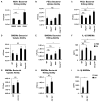Necroptosis Promotes Staphylococcus aureus Clearance by Inhibiting Excessive Inflammatory Signaling
- PMID: 27524612
- PMCID: PMC5001919
- DOI: 10.1016/j.celrep.2016.07.039
Necroptosis Promotes Staphylococcus aureus Clearance by Inhibiting Excessive Inflammatory Signaling
Abstract
Staphylococcus aureus triggers inflammation through inflammasome activation and recruitment of neutrophils, responses that are critical for pathogen clearance but are associated with substantial tissue damage. We postulated that necroptosis, cell death mediated by the RIPK1/RIPK3/MLKL pathway, would function to limit pathological inflammation. In models of skin infection or sepsis, Mlkl-/- mice had high bacterial loads, an inability to limit interleukin-1b (IL-1b) production, and excessive inflammation. Similarly, mice treated with RIPK1 or RIPK3 inhibitors had increased bacterial loads in a model of sepsis. Ripk3-/- mice exhibited increased staphylococcal clearance and decreased inflammation in skin and systemic infection, due to direct effects of RIPK3 on IL-1b activation and apoptosis. In contrast to Casp1/4-/- mice with defective S. aureus killing, the poor outcomes of Mlkl-/- mice could not be attributed to impaired phagocytic function. We conclude that necroptotic cell death limits the pathological inflammation induced by S. aureus.
Copyright © 2016 The Author(s). Published by Elsevier Inc. All rights reserved.
Figures







Similar articles
-
RIPK3 deficiency or catalytically inactive RIPK1 provides greater benefit than MLKL deficiency in mouse models of inflammation and tissue injury.Cell Death Differ. 2016 Sep 1;23(9):1565-76. doi: 10.1038/cdd.2016.46. Epub 2016 May 13. Cell Death Differ. 2016. PMID: 27177019 Free PMC article.
-
The Mitochondrial Phosphatase PGAM5 Is Dispensable for Necroptosis but Promotes Inflammasome Activation in Macrophages.J Immunol. 2016 Jan 1;196(1):407-15. doi: 10.4049/jimmunol.1501662. Epub 2015 Nov 18. J Immunol. 2016. PMID: 26582950 Free PMC article.
-
Necroptosis promotes cell-autonomous activation of proinflammatory cytokine gene expression.Cell Death Dis. 2018 May 1;9(5):500. doi: 10.1038/s41419-018-0524-y. Cell Death Dis. 2018. PMID: 29703889 Free PMC article.
-
Necroptosis and Inflammation.Annu Rev Biochem. 2016 Jun 2;85:743-63. doi: 10.1146/annurev-biochem-060815-014830. Epub 2016 Feb 8. Annu Rev Biochem. 2016. PMID: 26865533 Review.
-
The diverse role of RIP kinases in necroptosis and inflammation.Nat Immunol. 2015 Jul;16(7):689-97. doi: 10.1038/ni.3206. Nat Immunol. 2015. PMID: 26086143 Review.
Cited by
-
Distinct pseudokinase domain conformations underlie divergent activation mechanisms among vertebrate MLKL orthologues.Nat Commun. 2020 Jun 19;11(1):3060. doi: 10.1038/s41467-020-16823-3. Nat Commun. 2020. PMID: 32561735 Free PMC article.
-
Low dimensional nanomaterials for treating acute kidney injury.J Nanobiotechnology. 2022 Dec 1;20(1):505. doi: 10.1186/s12951-022-01712-2. J Nanobiotechnology. 2022. PMID: 36456976 Free PMC article. Review.
-
The double-edged functions of necroptosis.Cell Death Dis. 2023 Feb 27;14(2):163. doi: 10.1038/s41419-023-05691-6. Cell Death Dis. 2023. PMID: 36849530 Free PMC article. Review.
-
Necroptotic Cell Death Promotes Adaptive Immunity Against Colonizing Pneumococci.Front Immunol. 2019 Apr 4;10:615. doi: 10.3389/fimmu.2019.00615. eCollection 2019. Front Immunol. 2019. PMID: 31019504 Free PMC article.
-
Mechanisms of Tertiary Neurodegeneration after Neonatal Hypoxic-Ischemic Brain Damage.Pediatr Med. 2022 Aug 28;5:28. doi: 10.21037/pm-20-104. Pediatr Med. 2022. PMID: 37601279 Free PMC article.
References
MeSH terms
Substances
Grants and funding
LinkOut - more resources
Full Text Sources
Other Literature Sources
Medical
Molecular Biology Databases
Miscellaneous

